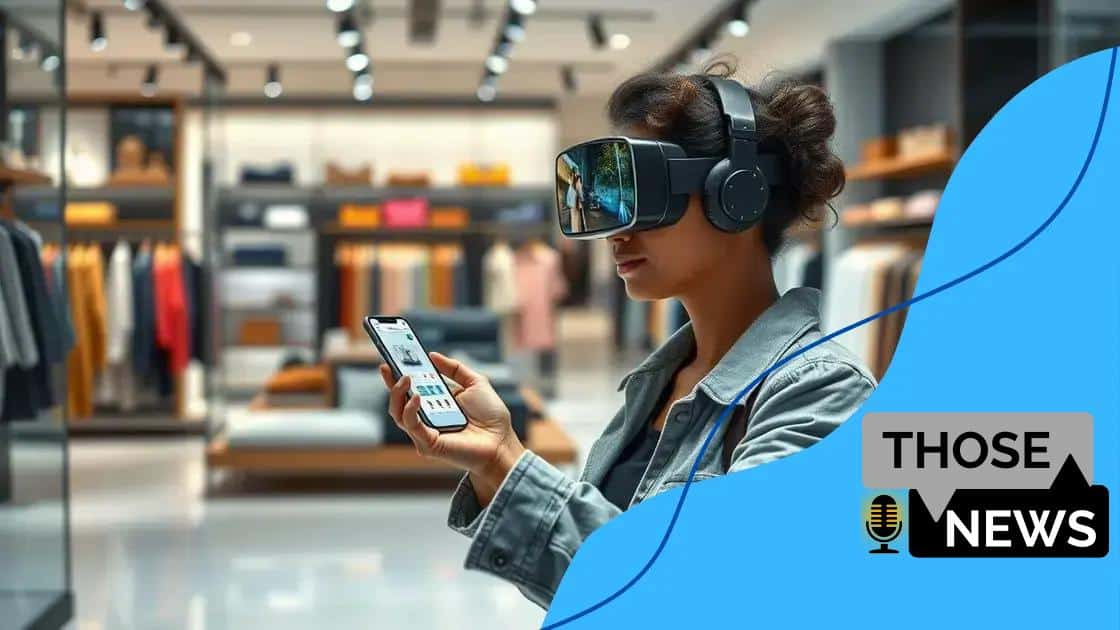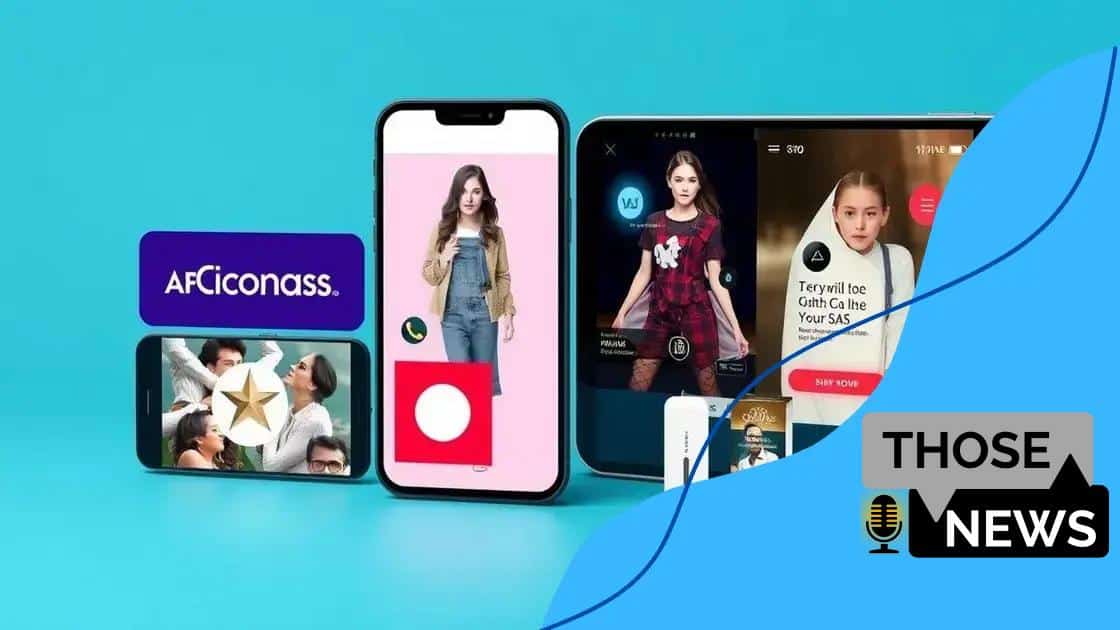Augmented reality in retail marketing: a game changer

Augmented reality in retail marketing enhances customer engagement and personalizes shopping experiences, allowing consumers to visualize products in innovative ways before making a purchase.
Augmented reality in retail marketing is changing how we see shopping. Imagine trying on clothes virtually or visualizing furniture in your home before buying. This technology isn’t just a gimmick; it’s reshaping consumer experiences and driving engagement in exciting ways.
Understanding augmented reality in retail
Understanding augmented reality in retail is essential for businesses looking to enhance customer experiences. This technology blends the physical and digital worlds, allowing customers to see products in new ways. By using smartphones or AR glasses, shoppers can interact with items without being in a store.
Augmented reality offers a unique shopping experience. For instance, customers can visualize how a piece of furniture looks in their home before purchasing. This feature not only boosts customer satisfaction but also increases the likelihood of sales. Moreover, AR can engage consumers through fun and interactive elements.
Key benefits of augmented reality in retail
Implementing augmented reality comes with several advantages:
- Enhances product interactivity and experience.
- Increases customer engagement and time spent on the brand’s platform.
- Reduces product returns by allowing better visualization.
- Stands out in a competitive market.
As retailers adopt this innovation, they create memorable experiences that resonate with tech-savvy consumers. Imagine each shopper entering a store and having access to information and visuals of products instantly. This seamless integration of AR transforms how we shop.
Examples of augmented reality applications in retail
Many brands are harnessing augmented reality to connect with customers:
- Makeup brands enabling virtual try-ons for cosmetics.
- Furniture stores offering apps to visualize items in homes.
- Fashion retailers allowing customers to see clothes on avatars.
These examples illustrate how AR fosters a deeper connection between brands and consumers. The innovative applications can help retailers understand their audience better and meet specific needs.
As this technology evolves, staying abreast of trends in augmented reality becomes crucial. Retailers who embrace this advancement position themselves as leaders in customer engagement. By offering unique experiences, they pave the way for future growth and customer loyalty.
Benefits of augmented reality for consumers
The benefits of augmented reality for consumers are numerous and impactful. As shopping evolves, AR provides a fresh, engaging way for customers to experience products. Imagine browsing items virtually and seeing them come to life right in front of your eyes.
One significant advantage of augmented reality is its ability to enhance customer confidence. By visualizing products in real-time, consumers can make more informed decisions. For example, someone can see how a piece of furniture looks in their living room before buying it.
Key advantages of augmented reality
Here are a few key benefits:
- Provides a personalized shopping experience for each consumer.
- Reduces the likelihood of returns as customers can see products better.
- Increases engagement through interactive features.
- Encourages impulse purchases by creating excitement.
With these advantages, shoppers feel more involved and excited about their buying decisions. This engagement often leads to higher satisfaction rates. Consumers appreciate the ease of trying things out without the hassle of visiting multiple stores.
Examples of AR in consumer experiences
Many brands use augmented reality to boost consumer benefits. Retailers like IKEA allow users to visualize furniture before they make a purchase. Makeup brands like L’Oreal offer virtual try-ons, enhancing consumer experiences while minimizing the mess of testers.
Additionally, AR can educate consumers about products in engaging ways. Shoppers can access details about items just by pointing their phones. This seamless connection to information builds trust and interest.
How brands are using augmented reality

Many brands are tapping into the power of augmented reality to enhance customer experiences and engagement. This technology is no longer just a novelty; it is becoming a vital tool in retail marketing strategies. Let’s explore how various companies are successfully integrating AR into their offerings.
One popular application is in the fashion industry, where brands like Gucci and Nike use AR to offer virtual try-ons. This feature allows customers to see how shoes or clothing look on them without entering a store. By using a smartphone or AR device, shoppers can visualize their purchases in real time, increasing satisfaction and reducing returns.
Industries benefiting from augmented reality
The impact of augmented reality spans several industries. For example:
- Home decor and furniture: Companies like IKEA provide an app that helps customers visualize furniture in their own homes before buying.
- Beauty: Brands like Sephora allow customers to try on makeup virtually, making it easier to choose the right shades.
- Automotive: Car manufacturers enable potential buyers to explore vehicles in a virtual space, enhancing the car buying experience.
As we see, augmented reality is transforming how consumers interact with products. These examples highlight how businesses are using AR to create immersive experiences, keeping customers engaged.
Innovative marketing campaigns
Many brands have launched innovative marketing campaigns that incorporate AR elements. For instance, Starbucks has utilized AR features in its app, allowing customers to interact with coffee cups in creative ways, enhancing the connection to the brand. Additionally, Coca-Cola has created AR experiences in its advertising, turning static images into interactive moments.
Through these creative pathways, brands are not only attracting attention but also building lasting relationships with consumers. This technology has the potential to create memorable experiences that consumers are likely to share, further promoting the brand.
Challenges of implementing augmented reality
Implementing augmented reality in retail comes with several challenges that businesses must address. While the potential benefits are considerable, understanding these obstacles is crucial for successful adoption. Companies often face both technical and strategic issues.
One major concern is the cost of development. Creating high-quality AR experiences requires significant investment in technology and skilled personnel. This can be daunting for smaller businesses. Additionally, staying updated with the continually evolving technology can strain budgets and resources.
Technical challenges in augmented reality
AR technology can be complex and demands specific technical capabilities:
- Incompatibility with existing systems can hinder seamless integration.
- Developing user-friendly interfaces is essential to attract consumers.
- Testing and ensuring performance across various devices require extensive resources.
- Security risks can arise, potentially compromising customer data.
These technical challenges emphasize the need for thorough planning before implementation. Brands must ensure the technology aligns with their goals and customer expectations. While AR can enhance shopping experiences, the technical aspects must not be overlooked.
Strategic challenges and consumer adaptation
There are also strategic hurdles businesses must navigate. Understanding the target audience’s needs is essential for success. Companies must ensure their AR offerings resonate with consumers. Additionally, educating consumers about how to use AR can be a challenge. Some customers may be hesitant to embrace new technology, which can slow adoption.
Moreover, without a clear strategy, brands might invest in AR features that don’t yield the expected results. Businesses must evaluate how augmented reality fits into their overall marketing strategy, ensuring it serves to enhance customer experience meaningfully.
Future trends in augmented reality marketing
Future trends in augmented reality marketing are shaping how brands interact with consumers. As technology evolves, businesses need to stay ahead of the curve to engage their audience effectively. The possibilities for AR are continuously expanding, leading to innovative strategies in the retail sector.
One of the most significant trends is the increasing use of artificial intelligence alongside augmented reality. AI can enhance AR experiences by personalizing content based on user behavior and preferences. This combination allows brands to create tailored experiences that resonate with individual customers, improving engagement and satisfaction.
Emerging technologies and their impact
New technologies are also playing a vital role in the evolution of AR marketing:
- 5G networks: The rollout of 5G is enabling faster data transfer, which makes AR experiences smoother and more immersive.
- Wearable devices: Smart glasses and AR-enabled wearables are becoming more popular, providing consumers with direct access to AR content in their daily lives.
- Integration with social media: Platforms like Instagram and Snapchat are increasingly featuring AR filters, allowing brands to reach a wider audience through engaging content.
As these technologies become more mainstream, brands will have more opportunities to create unique AR experiences. Customers will come to expect interactive and personalized shopping journeys that incorporate elements of augmented reality.
The rise of immersive storytelling
Another notable trend is the use of immersive storytelling in augmented reality marketing. Brands are developing narratives that consumers can experience through AR. This approach not only captures attention but also builds a deeper emotional connection between the brand and the customer.
Incorporating gamification elements will further enhance these experiences. By making shopping fun and engaging, brands can encourage consumers to interact with their products more actively.
As the AR landscape shifts, staying informed about these trends will be crucial for brands aiming to maintain a competitive edge. Businesses that embrace these innovations are set to lead the way in transforming the retail marketing landscape.
FAQ – Frequently Asked Questions about Augmented Reality in Retail Marketing
What are the main benefits of using augmented reality in retail?
The main benefits include enhanced customer engagement, reduced product returns, and personalized shopping experiences that improve satisfaction.
How can businesses implement augmented reality effectively?
Businesses can implement AR by investing in quality technology, understanding consumer needs, and creating user-friendly experiences.
What challenges do companies face when adopting augmented reality?
Companies may face challenges such as high development costs, technical integration issues, and ensuring consumer adaptation to the new technology.
What future trends should retailers watch in augmented reality?
Retailers should watch for trends like AI integration, immersive storytelling, and the use of 5G technology, which will enhance AR experiences.





